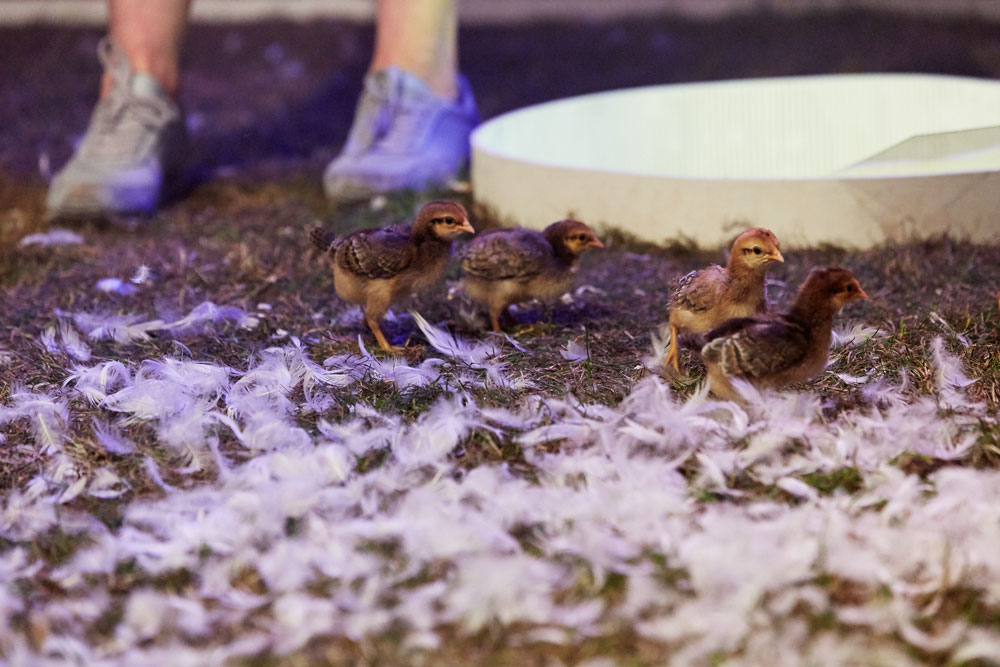We huddled from the rain under a small platform shelter at Hackney Wick the other night. Which was great, because it meant eavesdropping without strain on the couple arguing about This Beautiful Future, the play we’d just seen at the Yard Theatre. An amicable but irreconcilable disagreement, it boiled down to this:
HER: Lovely!
HIM: Offensive!
HER: Baby chicks!
HIM: Nazis!
Then the train arrived, so I have no idea if they were still speaking by Kensal Rise. I was fascinated, because I havered between the two positions. Despite Jay Miller’s acutely accomplished production with its headlong performances, and despite the dazzling intelligence of the text itself, I went to sleep troubled by Rita Kalnejais’ play, and woke more troubled still.
The evening plays brilliantly with a double perspective: the sugar-rush of first love and the hangover of ageing distance. Close-up optimism and long-lens melancholy. We first meet Alwyne Taylor and Paul Haley, older actors who introduce themselves as each makes for one of the karaoke booths on either side of the stage. They sing lovesongs (Adele, Charles Trenet) with the touching incongruity of people for whom you might expect puppy love to be only a memory.
Between them, a turf-covered circle is backed by a projection in raspberry-sundae colours of a small town (designer, Cécile Trémolières). In a a deserted house in provincial France, 1944, two teenagers rendezvous – town resident Élodie and Otto, a soldier in the occupying army. But there’s nothing period about the writing or acting. Brilliantly played by Bradley Hall and, especially, Hannah Millward, they’re utterly contemporary. Uptick inflections, trailing sentences, slang and sass and silliness. It’s essence of adolescence, 2017 model.
Kalnejais plunges into the squirm of teenage lust-love, all heart and hormone. But these aren’t any teens – spoilers ahead. There’s a war on, and the play very deliberately enmeshes them both in the horror. The Jewish owners of the house where they meet have, Otto insists, gone to their deaths. Their son was hidden with Élodie’s family – but her mother turned him out and he has almost certainly been killed – quite possibly by Otto himself. Éodie’s father is away – ‘in Hamburg, making buttons,’ which sounds like it covers a harsher truth. Otto has been part of a firing squad, killing political prisoners before the Allied forces arrive. They’re in this horrible war up to their necks – and Otto, at least, is ideologically committed to the atrocities.
Kalnejais was inspired to write by an image of a young Frenchwoman, shorn and shamed, after the liberation. ‘She’s meant to look guilty,’ the playwright has said, ‘and she doesn’t – she looks like the most innocent thing ever.’ Élodie’s 17, and Otto 15., and their ages seem crucial. This is the last point at which they might claim innocence, or at which adolescent desire might wash out the knowledge of their context. Never such innocence again. Two years older, and you’d not grant them a pass.
Kalnejais says she wanted to write something ‘hopeful, delicious and gorgeous’, and most responses to the play have foregrounded the lovely. Yet I registered it as a guilt story. She could have placed star-crossed lovers in a less emotive context; so it seems more a tale of complicity than intimacy. Yes, they’re ‘on the wrong side of history,’ as Matt Trueman writes – but they have in part placed themselves there. Each knows enough of what they’re getting into – the most rhapsodic version of a ‘beautiful future’ is Otto’s paean to ‘Mr Hitler’s’ cleansed Europe. It’s an uncomfortable statement of naivety on the very verge of adulthood, from someone carrying a smoking gun.
The fundamental things apply
What happens to the pair after they part, on the morning the Allied troops arrive, isn’t lovely either. The judgement we might consider is passed with severity: tar and feather for the hussy, a bullet for the brute. Are they youngsters facing a terror beyond their comprehension, or a guilty pair facing the consequences? Both, probably.
I thought of Casablanca. Rick and Ilsa insist the fundamental things apply, but they’re war-worn adults without illusions. The coda at the Yard – in which peeping baby chicks are released, in which Alwyne and Paul tend the youngsters (like their parents, their older selves, their songtime guardian angels) brought some to tears, and others to platform disagreement. We’re asked to stay our applause until the chicks are stowed, less we frighten them – and of course we do, we’re not monsters. It’s a real act with real consequences. What of the fictional acts and their consequences, how do we feel about them?
Kalnejais has a firm hand on the nuance of complicity, the halfway house between innocence and stained experience. In some ways, she writes more acutely about that blur than an overly neat Jez Butterworth does in The Ferryman. This Beautiful Future, from its teasing title to its morning-after pall, is a test of the audience. Where do we place responsibility? Is there enough lovely in the world to lift the horror? Lovely or offensive? Chicks or Nazis?
Photo by Richard Lakos
Follow David on Twitter – @mrdavidjays


Leave a Reply